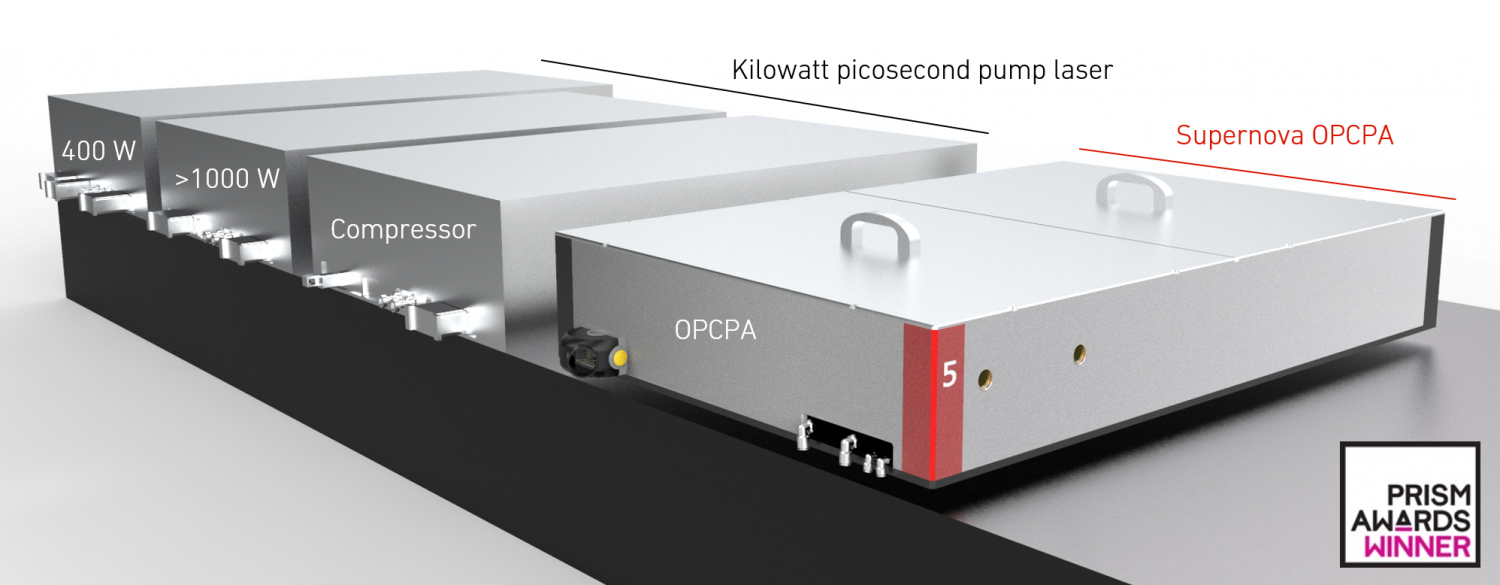Supernova OPCPA at 2 µm for water-window HHG to investigate challenges in modern chip-making
A new few-cycle, high-power OPCPA at 2 μm wavelength and scalability to 100 W average power with mJ pulses is built by Class 5 Photonics for a new brilliant soft X-ray source at the Advanced Research Center for Nanolithography (ARCNL) in Amsterdam.

By loading the video, you agree to YouTube's privacy policy.
Learn more
Our CEO Robert Riedel presented the status of this project at the OSA High-brightness sources conference (see video).
The motivation behind the work becomes clear by taking a look at modern chipmaking, enabled by EUV lithography at 13.5 nm wavelength.
Motivation
In modern chip-making, the nanometer-scale pattern of transistors on semiconductor wafers is being produced by exposing a negative photoresist layer on top of a semiconductor layer with EUV light at 13.5 nm wavelength. However, the development of such photoresist chemicals is a continuing challenge that targets, for example, the improvement of the photosensitivity.
Novel laser-based methods can be employed to find answers to such interesting questions. Higher-harmonic generation converts ultrashort mid-IR laser pulses to the soft X-ray regime. Thus, providing probes to investigate fascinating processes that are ultrafast on the attosecond scale and ultrasmall on the nanometer scale.
The planned brilliant soft X-ray source at ARCNL will be the first of its kind operating at 50 kHz pulse repetition rate. Consequently, it will deliver fifty times more pulses as compared to state of the art sources operating at 1 kHz. The targeted energy range from 200 to 600 eV can be utilized for advanced spectroscopy and metrology applications covering the important absorption edges of Carbon and Oxygen – enabling to trace the chemistry of organic materials, such as photoresists. Prominent application examples are coherent diffractive imaging (CDI) or attosecond transient absorption spectroscopy. These techniques are particularly relevant to study fundamental questions related to modern nanolithography and material science.
Supernova OPCPA
Class 5 Photonics is delivering the Supernova OPCPA as a powerful driver laser for efficient higher-harmonic generation (HHG) in the water window spectral range at high repetition rates. The Supernova OPCPA is a mid-infrared optical parametric chirped-pulse amplifier (OPCPA) system providing few-cycle, millijoule-level pulses at 50 kHz repetition rate scalable to 100 W average power.
The system is pumped by a kilowatt-class Yb:YAG InnoSlab or thin-disk picosecond laser (e.g. from Amphos GmbH). This powerful pump laser consists of a 400 W pre-amplifier, a kilowatt main amplifier, and a grating compressor. The compressed pump laser output is coupled to our Supernova OPCPA module (see picture below).
The Supernova OPCPA module itself contains a broadband seed generation centered at 2 μm wavelength with an enormous spectral bandwidth supporting about 20 fs pulses. The seed generation is based on our White Dwarf OPCPA module which can also be integrated as a stand-alone product. The OPCPA main amplifier is pumped at highest average power of about 800 W.
The Class 5 Photonics team has more than ten years of expertise in high-power nonlinear optics, advanced dispersion design and thermal management engineering. At the current status, we have successfully achieved about 1 mJ broadband pulses at 2 μm with the Supernova OPCPA.
In the next step the complete laser system will be implemented with the soft X-ray beamline at ARCNL.
